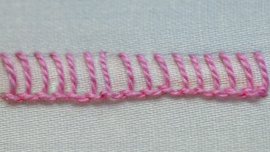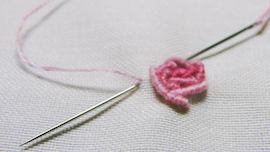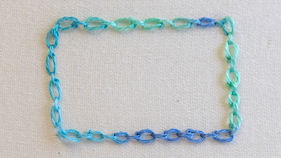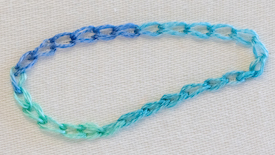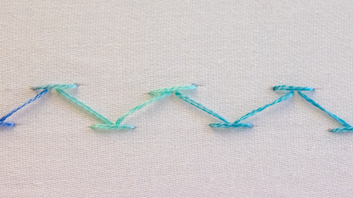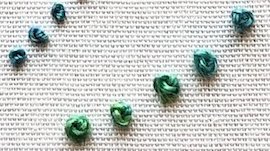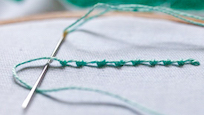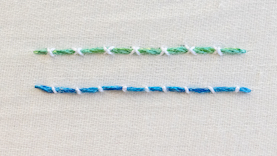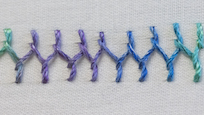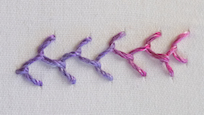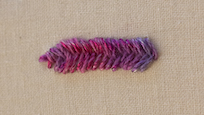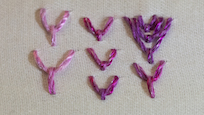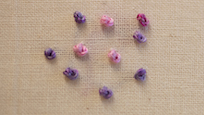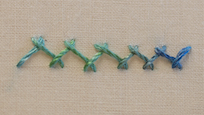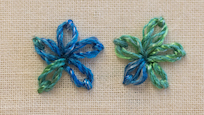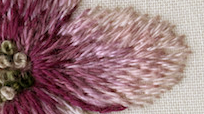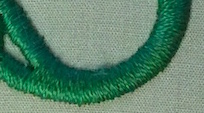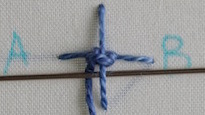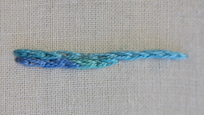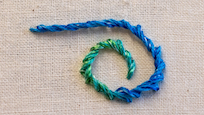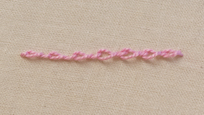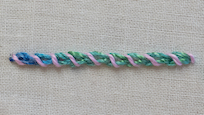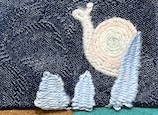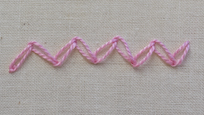- Home
- Basic embroidery stitches
Basic embroidery stitches are like building blocks for your project
I like to think of basic embroidery stitches as building blocks. Embroidery, much like any other skill, requires a strong foundation.
Learn and practise simple stitches until you know them by heart. You will find yourself returning to them regularly. In time, you will add more complex stitches to your repertoire. But the basic stitches will be the ones you use most.
Click on the links below each photo sample to find instructions. Many stitches have variations to try as well. Learn where and when to use them.
Even if you have been embroidering for years, you may learn something new. A stitch you haven't tried before. An easier way of creating stitches you have struggled with.
All you need is a hoop, fabric and embroidery floss to get started.
The stitches are listed in alphabetical order
Keep reading for more stitches
Create your own stitch sampler
I've been stitching since I was knee-high to a grasshopper. Over the years since then, I've gathered an impressive array of go-to stitches.
But what if you're just stepping into this hobby? Wondering what is the best stitch for a certain design element? We've all been there. Did you know it's possible to create a project with just one stitch? Don't be in a hurry to confuse matters by having to choose which one to use.
Practise on a piece of fabric, then keep that for future reference. Label it so you know the stitch name when you refer to it next time. Before long you will have your own embroidery stitch sampler.
Have patience, practice and persevere.
There are still more basic embroidery stitches further down the page
Starting at the beginning
Embroidery! Now there's a word that might make you feel all nostalgic, transporting you back to your granny's cozy living room. You might remember her, perched on her favourite chair, creating intricate, beautiful works of art with just a needle and thread. Her samplers and family heirlooms, delicately stitched, may have seemed like magic to your young eyes.
But before you wander off on a whimsical journey down memory lane, dreaming about emulating Granny's embroidery expertise, there's a teensy-weensy detail you need to take care of. And that is learning the basic embroidery stitches.
This elegant craft has a practical side too, popping up on your favourite jeans, bags, and hats, and even jazzing up your home decor, quilts, and curtains.
Now, you might be thinking, "That sounds great, but where do I start?"
Well, you could kick things off with a ready-made kit, but be warned, some kits can turn out to be as cryptic as a spy novel.
You see, some of them are not exactly beginner-friendly, offering nothing more than a quick diagram and a 'good luck' note for instructions. So, you might find yourself playing detective, trying to decipher the stitches from the diagram, which is, let's be honest, about as much fun as a game of charades with a mime.
But, don't let that put a damper on your embroidery dreams.
If you're lucky, the diagram might be labelled with the stitch name, giving you at least a chance to Google them or hunt them down in a book. Sure, it might take some time, but hey, Rome wasn't built in a day, right?
Choosing your basic embroidery stitches
Ever wonder if your embroidered masterpiece will become a fashion statement or maybe a cozy cushion? Or perhaps you're considering transforming your living room with a hand-stitched wall hanging? Well, my stitching friend, before you go threading that needle, there's a question you need to ponder. Is your stitch choice as practical as a Swiss army knife or as sensible as socks with sandals?
Think about it. If your embroidered beauty is going to adorn your favourite shirt, will it withstand the weekly wash, or will it surrender to the first spin cycle?
And let's not forget about those of you dreaming of a cushion. Will it be as comfy as a cloud or will those bumpy stitches feel like you're resting your head on a rock?
And tablecloth creators, will your embroidered surface be as smooth as a baby's bottom, preventing glasses from playing a game of dominoes at your dinner party?
As you delve deeper into the magical world of embroidery, you'll learn the answers to these questions and more. But until you become a stitch wizard, why not experiment with different stitches?
Create a basic embroidery stitch sampler
So, how about we take a leaf out of our Victorian child's book and play a little dress rehearsal with our stitches on a scrap of fabric?
After all, we wouldn't want to invest our precious time and effort into a piece, only to discover our chosen stitch is more of a fashion faux pas than a haute couture hit, would we?
Your little stitch experiments might just turn into a delightful project all on their own - a stitch sampler. Think of it as your very own stitching yearbook, a scrapbook of all the stitches you've met and mastered. Keep it tucked away in your needlework basket as a handy cheat-sheet for future projects.
Stitch samplers are not just a smart move, they're the perfect playground to hone your skills, and a great excuse to play a little fast and loose with your basic embroidery stitches.
Go on, make a 'happy little accident' or two - who knows, you might even stumble upon a brand spanking new stitch to add to your collection. After all, isn't that how all the great stitches of yore came to be?
Stay connected between projects
If you’d like occasional updates from my embroidery room, including new patterns, gentle tips, and little things I think you might enjoy, you’re warmly invited to join the Stitchin’ Times newsletter.
No pressure. Just a friendly note now and then to keep you inspired.
